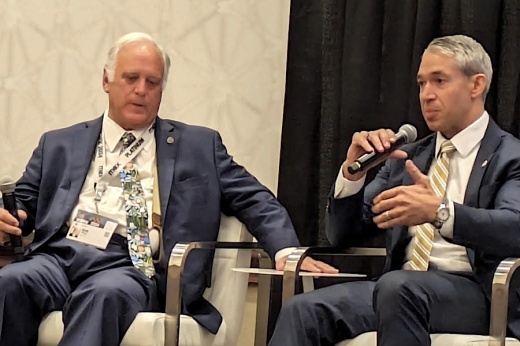What happened
Austin Mayor Kirk Watson and San Antonio Mayor Ron Nirenberg were joined by Quinton Lucas—mayor of Kansas City, Missouri—at the Hilton Austin to share thoughts and best practices concerning training and retaining various types of workers for local industries in their respective growing city.
Watson said Austin City Council’s approval of an Austin Infrastructure Academy on March 7 is a milestone for the city. According to the council’s adopted resolution, the private/public infrastructure network will integrate recruitment, a comprehensive training hub, child care support and placement services to connect local residents to infrastructure career pathways.
Those pathways, Watson said, include engineering, planning, managing and building mass transit improvements around town, and expanding Austin-Bergstrom International Airport.
Austin officials said their long-term, large capital projects will need skilled infrastructure workers, expanding the region’s infrastructure sector by more than 81% by 2040—an expansion that will rely on addition of 10,000 new workers annually for the next 17 years.
But Watson said this initiative must also take into account factors such as ensuring housing is affordable for a large range of people in town to fill those jobs for which they are training.
“Our economic development paradigm needs to evolve,” Watson said.
Nirenberg talked about San Antonio Ready to Work, a program where the city of San Antonio, local employers, training providers, colleges, community organizations and workforce agencies collaborate to train individuals for certain career pathways.
The idea, Nirenberg said, is to provide trainees with resources, such as transportation, child care, tuition aid, job interview preparation, and help with developing a personalized career and training plan.
Initial enrollment for San Antonio Ready to Work opened in May 2022 and, by fall of 2023, city officials recorded nearly 5,000 enrollees, but fewer than 800 of those enrollees had successfully completed that training by that point.
Nirenberg said he and fellow San Antonio leaders learned their lesson, tempered early expectations with Ready for Work, adding that this and other measures are needed to further bolster San Antonio’s economy and workforce.
“We are anticipating training up to 40,000 people over the next five to eight years. It’s an opportunity not only to train folks to get into the jobs that we are creating in the modern economy, but also finally break cycles of poverty,” Nirenberg said.
A closer look
Watson said the Austin Infrastructure Academy is not meant to reinvent the wheel in matters of workforce development but rather help to scale up existing efforts.
Watson added improving a city’s talent pipeline is not just about filling jobs, but having public and private sectors collaborate to enhance the availability of various career fields and ensuring the right people pursue those careers with child care, transportation and housing needs met.
“Child care is the second largest expense in most households behind the cost of housing. If you have children, it's making all of the difference in people thinking, ‘Do I work a part-time job? Can I take this job? When it comes to establishing your career, can I do the training I need to do?’” Watson said.
Watson said it is important that Austin's government and business leaders continue work on making for a community where residents have access to all essential services and amenities, including affordable housing and public transit, in order for them to focus on finishing their education if that is a goal and to pursue a good-paying, rewarding job.
“I frankly don't believe that we will be the kind of complete city we want to be if people are moving out because they can't afford to be here, or if they don't believe the city cares about them,” Watson said.
Nirenberg agreed with Watson's sentiment, saying workforce development programs such as San Antonio Ready to Work must function in a way to help participants in most personal situations, especially emergencies.
“The real power of Ready to Work is that we have navigators that work with each individual to anticipate and help overcome those barriers. There's assistance built into for each and every one of those participants, but everybody's got different needs, and we've got to work with individuals from the very beginning,” Nirenberg said.
Nirenberg also said partnerships with the private sector are vital because that raises confidence of participants.
“Getting those employers to commit jobs upfront tells the participants on the front end that there's a job waiting for them that they can successfully complete this program,” he added.





